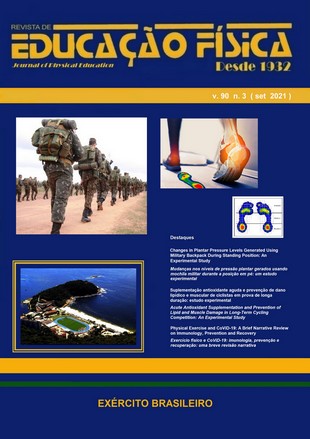Abstract
Introduction: African athletes predominated long distance running in athletics for some decades. Nevertheless, running strategy phenomenon still need further investigation.
Objective: To compare the running strategy in African and non-African 5.000 m runners during competition event.
Methods: Data were extracted from 43 athletes from the men's 5.000m finals of the last three world championships. These athletes were divided into two groups: African (n=30) and non-African (n=13) athletes. The velocity reached at each kilometer was used to determine the running strategy.
Results: There was no difference in running velocity throughout the splits (km) between the groups. The splits 1 and 2 were smaller than the other splits and the splits 3 and 4 were smaller than the split 5 (p<0.05).
Conclusion: There was no difference in the running strategy between African and non-African athletes and the running velocity tends to increase throughout the race.
References
Saltin B, Kim CK, Terrados N, Larsen H, Esvedenhag J, Rolf CJ. Morphology, enzymen activities and buffer capacity in leg muscles of Kenyan and Scandinavian runners. Scandinavian Journal of Medicine & Science in Sports. 1995;5(4):222-30 doi: 10.1111/j.1600-0838.1995.tb00038.x
Larsen HB. Kenyan dominance in distance running. Comparative Biochemistry and Physiology Part A: Molecular & Integrative Physiology. 2003;136(1):161-170. doi: 10.1016/s1095-6433(03)00227-7
Joyner MJ, Ruiz JR, Lucia A. The two-hour marathon: who and when? Journal of Applied Physiology. 2011;110:275–277 doi: 10.1152/japplphysiol.00563.2010
Foster C, Hoyos J, Earnest C, Lucia A. Regulation of Energy Expenditure during Prolonged Athletic Competition. Medicine & Science in Sports & Exercise. 2005;37(4):670-675. Doi: 10.1249/01.mss.0000158183.64465.bf
Mooses M, Hackney AC. Anthropometrics and Body Composition in East African Runners: potential impact on performance. International Journal of Sports Physiology and Performance. 2017;12(4):422-430. doi: 10.1123/ijspp.2016-0408
Bosch AN, Goslin BR, Noakes TD, Dennis SC. Physiological differences between black and white runners during a treadmill marathon. European Journal of Applied Physiology and Occupational Physiology. 1990;6191-2):68–72.
Weston AR, Karamizrak O, Smith A, Noakes TD, Myburgh KH. African runners exhibit greater fatigue resistance, lower lactate accumulation, and higher oxidative enzyme activity. Journal of Applied Physiology. 1999;86:915-923. doi: 10.1152/jappl.1999.86.3.915
Abbiss CR, Laursen PB. Describing and understanding pacing strategies during athletic competition. Sports Medicine. 2008;38(3):239-252. doi: 10.2165/00007256-200838030-00004
Tucker R, Lambert MI, Noakes TD. An analysis of pacing strategies during men's world-record performances in track athletics. International Journal of Sports Physiology and Performance. 2006 (3):233-45. doi: 10.1123/ijspp.1.3.233.
Manoel FA, Kravchychyn ACP, Alves JCC, Machado FA. Influência do nível de performance na estratégia de ritmo de corrida em prova de 10 km de corredores recreacionais. Revista Brasileira de Educação Física e Esporte. 2015;29(3):355-360. Doi: 10.1590/1807-55092015000300355
Borba DA, Silva ALF, Caldeira RR, Ferreira-Júnior JB. Influência de diferentes níveis de desempenho na estratégia de corrida durante os 10 mil metros do Campeonato Mundial de Atletismo: um estudo retrospectivo (2015 e 2017). Revista de Educação Física / Journal of Physical Education. 2020;88(4):989-998. doi: 10.37310/ref.v88i4.848
Ulmer HV. Concept of an extracellular regulation of muscular metabolic rate during heavy exercise in humans by psychophysiological feedback. Experientia. 1996;52(5):416-420. doi:10.1007/BF01919309
Tucker R, Noakes TD. The physiological regulation of pacing strategy during exercise: a critical review. British Journal of Sports Medicine. 2009;43(6):e1–e1. doi:10.1136/bjsm.2009.057562
St Clair Gibson A, Swart J, Tucker R. The interaction of psychological and physiological homeostatic drives and role of general control principles in the regulation of physiological systems, exercise and the fatigue process – The Integrative Governor theory. European Journal of Sport Science. 2018. 18(1):25-36. doi: 10.1080/17461391.2017.1321688
Lima-Silva, AE, Bertuzzi RCM, Pires FO, Barros RV, Gagliardi JF, Hammond J et al. Effect of performance level on pacing strategy during a 10-km running race. European Journal of Applied Physiology. 2010;108(5):1045-1053 doi: 10.1007/s00421-009-1300-6
Noakes TD. From catastrophe to complexity: a novel model of integrative central neural regulation of effort and fatigue during exercise in humans: summary and conclusions. British Journal of Sports Medicine. 2005;39(2):120-124. doi:10.1136/bjsm.2003.010330
Noakes TD. The Central Governor Model of Exercise Regulation Applied to the Marathon: Sports Medicine. 2007;37(4):374377. doi:10.2165/00007256-200737040-00026
Amann M. Central and peripheral fatigue: interaction during cycling exercise in humans. Medicine and Science in Sports and Exercise. 2011;43(11): 2039-2045. doi: 0.1249/MSS.0b013e31821f59ab

This work is licensed under a Creative Commons Attribution 4.0 International License.
